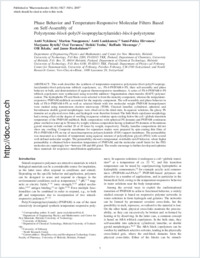Phase behavior and temperature-responsive molecular filters based on self-assembly of polystyrene-block-poly(n-isopropylacrylamide)-block-polystyrene
- Nykänen, Antti Department of Engineering Physics and Mathematics and Center for New Materials, Helsinki University of Technology, Finland
- Nuopponen, Markus Department of Chemistry, University of Helsinki, Finland
- Laukkanen, Antti Department of Chemistry, University of Helsinki, Finland - Drug Discovery and Development Technology Center, Faculty of Pharmacy, University of Helsinki, Finland
- Hirvonen, Sami-Pekka Department of Chemistry, University of Helsinki, Finland
- Rytelä, Marjaana Department of Chemical Technology, Helsinki University of Technology, Finland
- Turunen, Ossi Department of Chemical Technology, Helsinki University of Technology, Finland
- Tenhu, Heikki Department of Chemistry, University of Helsinki, Finland
- Mezzenga, Raffaele Department of Physics ad Fribourg Center for Nanomaterials, University of Fribourg, Switzerland - Nestlé Research Center, Vers-Chez-les-Blanc, Lausanne, Switzerland
- Ikkala, Olli Department of Engineering Physics and Mathematics and Center for New Materials, Helsinki University of Technology, Finland
- Ruokolainen, Janne Department of Engineering Physics and Mathematics and Center for New Materials, Helsinki University of Technology, Finland
-
06.07.2007
Published in:
- Macromolecules. - 2007, vol. 40, no. 16, p. 5827 -5834
English
This work describes the synthesis of temperature-responsive polystyrene-block-poly(N-isopropylacrylamide)-block-polystyrene triblock copolymers, i.e., PS-b-PNIPAM-b-PS, their self-assembly and phase behavior in bulk, and demonstration of aqueous thermoresponsive membranes. A series of PS-b-PNIPAM-b-PS triblock copolymers were synthesized using reversible addition-fragmentation chain transfer (RAFT) polymerization. The hydrophobic PS end blocks were selected to form the minority component, whereas the temperature-responsive PNIPAM midblock accounted for the majority component. The self-assembly and phase behavior in bulk of PS-b-PNIPAM-b-PS as well as selected blends with low molecular weight PNIPAM homopolymers were studied using transmission electron microscopy (TEM). Classical lamellar, cylindrical, spherical, and bicontinuous double gyroid morphologies were observed in the dried state. In aqueous solutions, the glassy PS domains act as physical cross-links, and hydrogels were therefore formed. The bulk block copolymer morphology had a strong effect on the degree of swelling in aqueous solutions upon cooling below the coil-globule transition temperature of the PNIPAM midblock. Bulk compositions with spherical PS domains and PNIPAM continuous phase swelled in water up to 58 times by weight, whereas composition having cylindrical PS domains or bicontinous gyroid structure in bulk swelled 20 or 10 times by weight, respectively. Finally, lamellar compositions did not show any swelling. Composite membranes for separation studies were prepared by spin-coating thin films of PS-b-PNIPAM-b-PS on top of meso/macroporous polyacrylonitrile (PAN) support membrane. The permeability was measured as a function of temperature using aqueous mixture of poly(ethylene glycol) (PEG) with several well-defined molecular weights. The permeability showed a temperature switchable on/off behavior, where higher permeability is obtained below transition temperature of PNIPAM, and the molecular cutoff limits for the PEG molecules are surprisingly low-between 108 and 660 g/mol. The results encourage to further develop and optimize these materials for responsive nanofiltration applications.
- Faculty
- Faculté des sciences et de médecine
- Department
- Département de Physique
- Language
-
- English
- Classification
- Physics
- License
-
License undefined
- Identifiers
-
- RERO DOC 9331
- DOI 10.1021/ma070378i
- Persistent URL
- https://folia.unifr.ch/unifr/documents/300678
Statistics
Document views: 126
File downloads:
- pdf: 251
